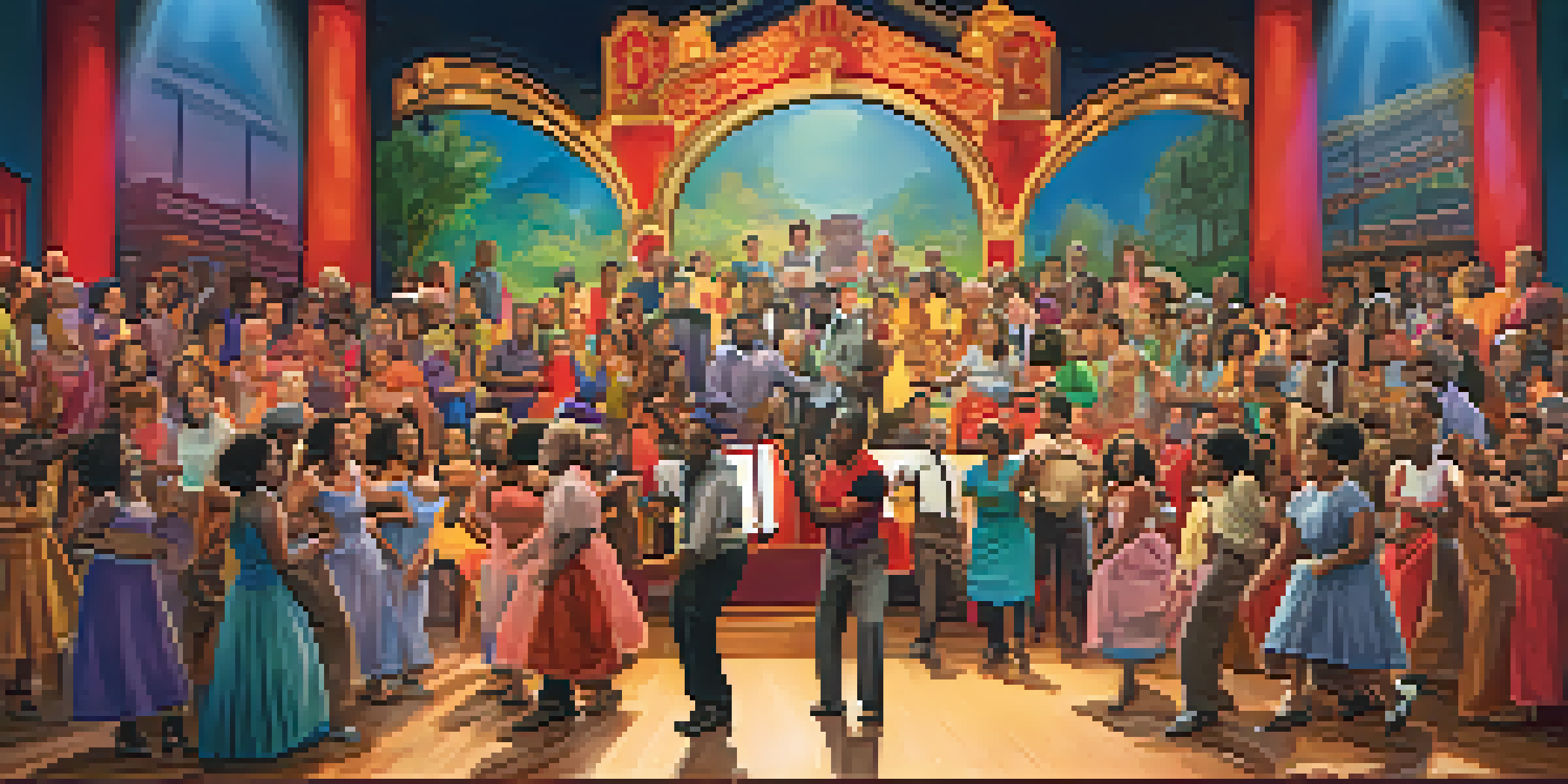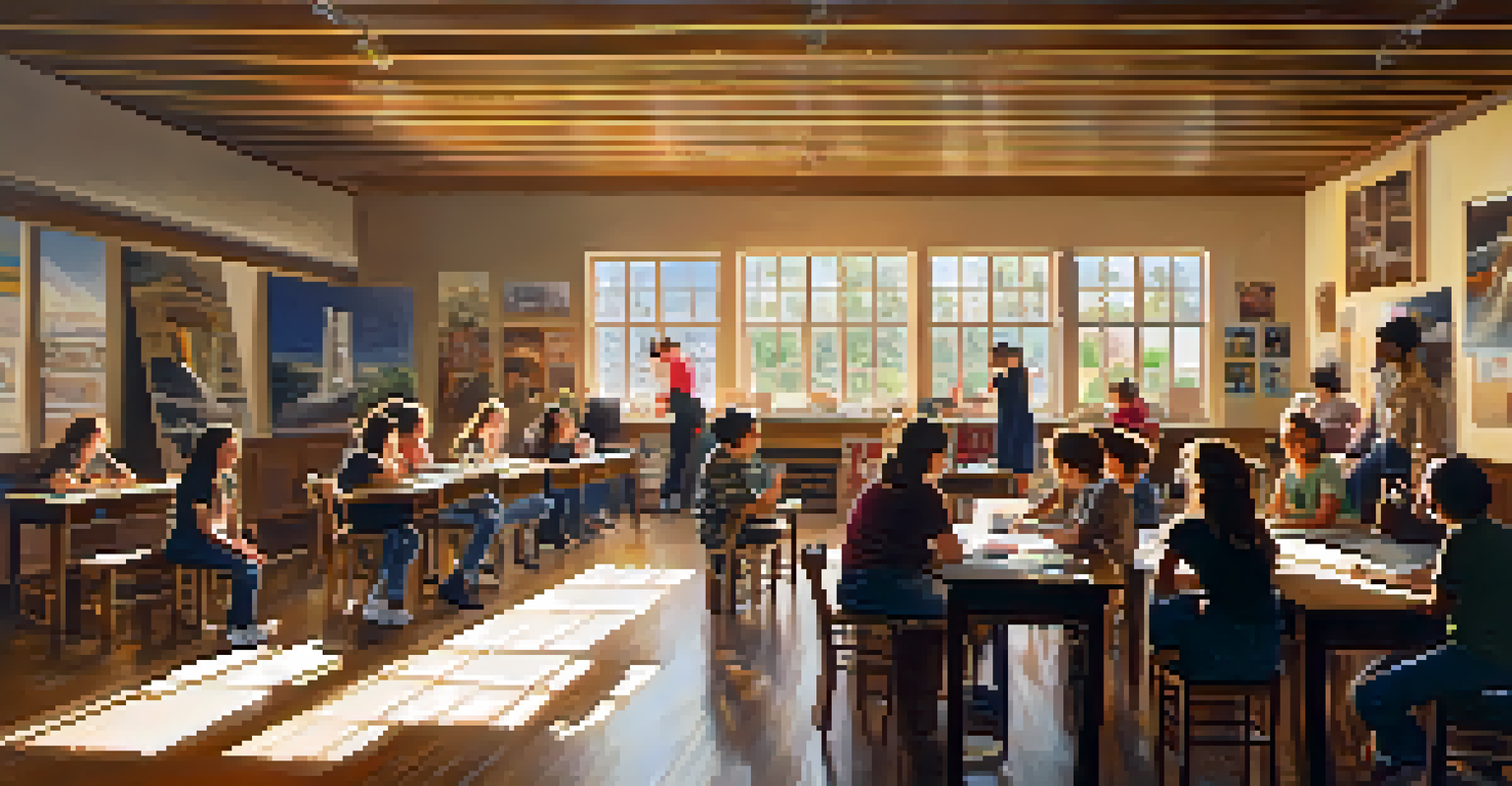The Role of Community Theater in Austin's Arts Landscape

The Heartbeat of Austin's Creative Community
Community theater serves as a vital part of Austin's arts landscape, embodying the city's spirit of creativity and collaboration. It provides a platform for local actors, directors, and playwrights to showcase their talents and tell their stories. By bringing together diverse voices, these theaters foster a sense of belonging and identity within the community.
The theater is a great source of social awareness. It can be a powerful agent of change, bringing people together to discuss issues that matter.
In Austin, community theaters often act as incubators for emerging artists, allowing them to hone their craft in a supportive environment. Many local productions feature original scripts, showcasing the unique experiences and perspectives of Austin's residents. This emphasis on local storytelling not only enriches the theater scene but also strengthens community ties.
Moreover, community theater often engages with local issues and themes, making performances relatable and relevant to audiences. Whether it's a comedic take on everyday life or a poignant drama addressing social concerns, these productions resonate deeply with viewers. As a result, they become a mirror reflecting the community's joys, struggles, and aspirations.
A Platform for Diverse Voices and Stories
One of the most beautiful aspects of community theater in Austin is its commitment to inclusivity. These theaters actively seek to represent diverse voices and narratives, ensuring that everyone feels seen and heard. This dedication to diversity enriches the artistic offerings available to audiences, making the theater a space for different cultures and perspectives.

For instance, many community theaters collaborate with local organizations and schools to promote underrepresented artists and stories. By hosting workshops and open auditions, they create opportunities for individuals from various backgrounds to participate in the artistic process. This not only diversifies the talent pool but also enhances the overall quality of productions.
Community Theater's Role in Austin
Community theater fosters creativity and collaboration, serving as a platform for local artists to share their stories.
The result is a tapestry of performances that celebrate the richness of Austin's cultural fabric. Audiences can experience everything from bilingual plays to works that delve into specific cultural traditions. This vibrant mix of stories fosters understanding and empathy, bridging gaps between different communities.
Building Community Through Collaboration
Community theater in Austin thrives on collaboration, bringing together individuals from various artistic disciplines. Actors, writers, musicians, and visual artists unite to create a cohesive experience that transcends traditional theater. This collaborative spirit often leads to innovative productions that challenge the status quo and engage audiences in new ways.
Art is not freedom from discipline, but disciplined freedom.
For example, many community theaters partner with local musicians to incorporate live music into their shows, adding an extra layer of engagement. These collaborations often spark creative ideas, resulting in unique interpretations of classic plays or entirely new works. It’s a testament to how community theater can push artistic boundaries while remaining grounded in local talent.
Furthermore, these collaborations extend beyond the stage, with community theaters hosting workshops and events that encourage skill-sharing and networking. This fosters a sense of camaraderie among artists, reinforcing the idea that everyone plays a crucial role in the creative process. Ultimately, this interconnectedness enhances the entire arts landscape in Austin.
Educational Opportunities for Aspiring Artists
Community theaters play a critical role in fostering the next generation of artists through their educational programs. Many local theaters offer classes, workshops, and camps designed for all ages, providing aspiring performers with the skills they need to thrive. This commitment to education ensures that the arts remain accessible to everyone, regardless of experience level.
These programs often focus on various aspects of theater, from acting and directing to set design and stage management. By equipping participants with a well-rounded understanding of theatrical production, community theaters help cultivate a new wave of talent. This investment in education not only benefits individual artists but also strengthens the overall arts community in Austin.
Inclusivity and Diverse Voices
Austin's community theaters prioritize inclusivity, representing a rich tapestry of cultural narratives that resonate with diverse audiences.
Moreover, these educational initiatives often emphasize the importance of teamwork and collaboration, mirroring the real-world experiences students will face in the industry. Participants learn to work together to create something greater than themselves, fostering important life skills that extend beyond the stage. In this way, community theater becomes a nurturing ground for both artistic and personal growth.
Cultivating a Passion for the Arts in Youth
Community theater has a profound impact on young people's lives by cultivating a passion for the arts. Through engaging performances and hands-on workshops, children and teens are introduced to the world of theater in a fun and supportive environment. This early exposure often ignites a lifelong love for the arts.
In Austin, many community theaters prioritize outreach programs that bring theater to schools and underserved neighborhoods. These initiatives create opportunities for young people to experience live performances and participate in theatrical activities, regardless of their backgrounds. By democratizing access to the arts, these programs inspire creativity and self-expression among the youth.
Additionally, involvement in community theater helps young participants build confidence and social skills. Whether performing in front of an audience or collaborating with peers, they learn valuable lessons about teamwork, resilience, and self-discipline. These experiences can be transformative, empowering young individuals to pursue their passions and embrace their unique voices.
Economic Impact of Community Theater in Austin
Beyond its artistic contributions, community theater also plays a significant role in Austin's economy. Local productions attract audiences from all over the city and beyond, generating revenue for nearby businesses, such as restaurants and shops. This economic boost underscores the interconnectedness of the arts and local commerce.
Moreover, community theaters create job opportunities for artists, technicians, and administrative staff. By employing local talent and sourcing materials from nearby vendors, these theaters contribute to the economic ecosystem of Austin. This economic impact extends to the community as a whole, creating a ripple effect that benefits various sectors.
Economic and Social Impact
Beyond art, community theaters boost the local economy and spark important social dialogues, making them essential to Austin's cultural landscape.
Furthermore, community theater often plays a role in attracting tourism, as visitors seek out unique cultural experiences during their stay. Festivals, special events, and seasonal performances draw in crowds, further enhancing the city’s reputation as an arts destination. In this way, community theater not only enriches the cultural landscape but also supports Austin's economic vitality.
Community Theater as a Space for Dialogue
Community theater serves as an important space for dialogue on pressing social issues. Many local productions tackle topics such as inequality, environmental concerns, and mental health, encouraging audiences to engage in meaningful conversations. This ability to spark dialogue makes community theater a powerful tool for social change.
By presenting thought-provoking narratives, these theaters create opportunities for audiences to reflect on their own experiences and beliefs. The intimate nature of community performances allows for a deeper connection between the actors and the audience, fostering an environment where discussions can flourish. Audiences often leave performances inspired to take action or consider new perspectives.

Moreover, community theaters frequently host post-show discussions and panels, inviting audience members to share their thoughts and engage with the themes presented. This collaborative approach reinforces the idea that theater is not just a form of entertainment, but a catalyst for societal reflection and growth. In this way, community theater becomes a vital forum for discussing the complexities of modern life.